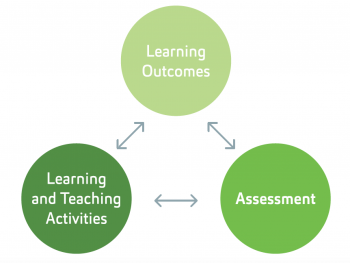CTVSD1/Introduction/How
Most of the time when you are designing courses or modules you are already provided with the learning outcomes or competencies to be achieved. Probably that is the case for the module you have picked to work on as your learning project. There also could be instances when you are working on designing a new course or revising a course and you need to write the learning outcomes or competencies. In either case it is important to understand and know how learning outcomes or competencies are relevant to the learning activities and assessments you create.
It comes down to a simple fact: learning outcomes, learning activities, and assessment all need to be aligned. Having clear outcomes is key but not enough. Once you know exactly what learners need to achieve you need to design appropriate and relevant assessments to assess the outcomes and provide reliable evidence that they have been met at the expected level. It is also critical that all teaching and learning activities assist and support the learner to learn the skills and behaviours expected to meet the desired outcomes. This is called constructive alignment [1].
The ‘constructive’ aspect refers to what the learner does, which is to construct their own meaning and develop skills and competencies through relevant learning activities. The ‘alignment’ aspect refers to what the educator or trainer does, which is to set up a learning environment that supports the learning activities appropriate to achieving the desired outcomes. The key is that the components in the system - the learning outcomes, the teaching and learning experiences and the assessment tasks are all coherent and aligned.
Writing good outcome statements
If you are writing or revising your course or module outcomes follow the SMART model. An acronym that has many variations but in essence means the outcomes need to be:
- Specific: clear and focused describing expected skills, knowledge, behaviour, and performance.
- Measurable: learning can be assessed through evidence, observation, or other concrete ways.
- Attainable or Appropriate or Achievable: doable and within any limits of the learner or learning level.
- Relevant: the outcomes are relevant to what is to be learned / achieved.
- Timebound: can be accomplished in the time accorded.
Interpreting competencies or professional standards
If you are working with a professional qualification you learners are likely to be assessed against competency standards or professional standards (often called units of competency). They are developed by industry to assess competency. A competency standard usually comprises of individual units of competency and elements that include the essential information needed to assess a learner. Information on the qualifications and relevant units of competency are usually outlined in accredited courses or training packages. If you are working with one of those this is the time to look at the defined outcomes and make sure you understand them fully. Consult with a master craftsperson or industry professional if you are not currently working in the vocation.
Whether you are working with outcomes already defined in your qualification document or you are writing them for you new module the following video will help you analyse outcomes and define clear performance criteria. Having clear performance criteria is of great importance for the following reasons:
- clearly defines the level of performance expected in a measurable and observable way,
- provides clarity on what is assessed,
- aids consistency of achievement of competency or outcomes no matter where the training is happening and the different trainers delivering it.
